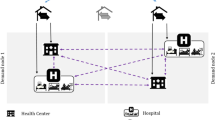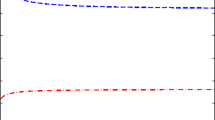Abstract
Vaccination is the best way to build an immune barrier to control a new infectious disease. Considering the limited production capacity at the initial stage of vaccine production, the problem of multistage vaccine production and allocation is studied under the policy of free treatment for infected patients by the government. Given the population and infection rates of different regions and the vaccine production capacity of each stage, an integer programming model is established to minimize the sum of production-and-vaccination cost and treatment cost of infected patients, which is solved by the GUROBI solver. The correctness of the model is verified by simulation, and the necessity of considering the treatment cost of infected patients in the objective function is further analyzed, which confirmed the correctness of the free treatment policy for patients in China. A heuristic algorithm is designed to solve the large-scale problem and numerical experiments are conducted to verify the efficiency of this algorithm. Furthermore, based on the sensitivity analysis results of parameters, the optimal vaccine production and allocation strategy are proposed, which provide the decision basis for the government departments to make reasonable vaccine production and vaccination plan.
Similar content being viewed by others
References
Cohen M, Changing patterns of infectious disease, Nature, 2000, 406(6797): 762–767.
Matrajt L, Eaton J, Leung T, et al., Vaccine optimization for COVID-19: Who to vaccinate first? Science Advances, 2021, 7(6): eabf1374.
Pei S, Review of vaccines and immunization by Chuanxi Fu (editor-in-chief), Human Vaccines and Immunotherapeutics, 2021, 17(6): 1785–1786.
Yarmand H, Ivy J S, Denton B, et al., Optimal two-phase vaccine allocation to geographically different regions under uncertainty, European Journal of Operational Research, 2014, 233(1): 208–219.
Choi M J, Choi W S, Seong H, et al., Develo** a framework for pandemic COVID-19 vaccine allocation: A modified Delphi consensus study in Korea, Journal of Korean Medical Science, 2021, 36(23): 1–13.
Tajudeen R, COVID-19 vaccines: How to ensure Africa has access? Nature, 2020, 586: 197–199.
**a N S and Zhang T Y, COVID-19 raises new signs of hope, Bulletin of National Natural Science Foundation of China, 2021, 35(2): 223–224 (in Chinese).
Mallapaty S, China’s COVID vaccines are going global — But questions remain, Nature, 2021, 593: 178–179.
National Health Commission of the People’s Republic of China, Press conference of the joint prevention and control mechanism of the state council on December 19, 2020, http://www.nhc.gov.cn/xcs/yqfkdt/202012/dd603e667f6d47238a8998860f8b9c0a.shtml/.
The Central People’s Government of the People’s Republic of China, China had administered over 1 billion doses of COVID-19 vaccines, it is expected that at least 70 percent of its population will be vaccinated by the end of the year, http://www.gov.cn/xinwen/2021-06/21/content_5619729.htm/.
Wan S Y, Liu J, and Min L, Progress on the basic reproduction number of SARA-CoV-2, Chinese Science Bulletin, 2020, 65(22): 2334–2341 (in Chinese).
O’Driscoll M, Santos, G R D, Wang L, et al., Age–specific mortality and immunity patterns of SARS-CoV-2, Nature, 2021, 590: 140–145.
Yang H L, Wu Y Y, and Lin X Y, New coronavirus pneumonia, population migration and epidemic prevention and control, Chinese Journal of Management Science, 2020, 28(3): 1–10 (in Chinese).
Ball F G and Lyne O D, Optimal vaccination policies for stochastic epidemics among a population of households, Mathematical Biosciences, 2002, 177–178: 333–354.
Tanner M W, Sattenspiel L, and Ntaimo L, Finding optimal vaccination strategies under parameter uncertainty using stochastic programming, Mathematical Biosciences, 2008, 215(2): 144–151.
Shayak B and Sharma M M, COVID-19 spreading dynamics with vaccination-allocation strategy, return to normalcy and vaccine hesitancy, Medrxiv, 2020, DOI: https://doi.org/10.1101/2020.12.10.20247049.
Tanner M W and Ntaimo L, IIS branch-and-cut for joint chance-constrained stochastic programs and application to optimal vaccine allocation, European Journal of Operational Research, 2010, 207(1): 290–296.
Tavana M, Govindan K, Nasr A K, et al., A mathematical programming approach for equitable COVID-19 vaccine distribution in develo** countries, Annals of Operations Research, 2021, DOI: https://doi.org/10.1007/s10479-021-04130-z.
Sy C, Aviso K, Cayamanda C, et al., Process integration models for emerging challenges: Optimal allocation of antivirals under resource constraints, Clean Technologies and Environmental Policy, 2020, 22: 1359–1370.
Author information
Authors and Affiliations
Corresponding author
Ethics declarations
The authors declare no conflict of interest.
Additional information
This research was jointly supported by Bei**g Natural Science Foundation under Grant Nos. 9212004 and Z180005, the National Natural Science Foundation of China under Grant No. 71771028, Municipal University’s High-Level Innovation Team Construction Program in 2018 under Grant No. IDHT20180510, Precision and Advanced Subject Construction Foundation (Municipal Level), and Capital University of Economics and Business Student Academic Newcomer under Grant No. 2022XSXR06.
Rights and permissions
About this article
Cite this article
Han, Q., Zhang, Y., Li, Z. et al. Study on the Problem of Multistage Vaccine Production and Allocation with Capacity Constraints. J Syst Sci Complex 36, 2046–2066 (2023). https://doi.org/10.1007/s11424-023-2065-4
Received:
Revised:
Published:
Issue Date:
DOI: https://doi.org/10.1007/s11424-023-2065-4




